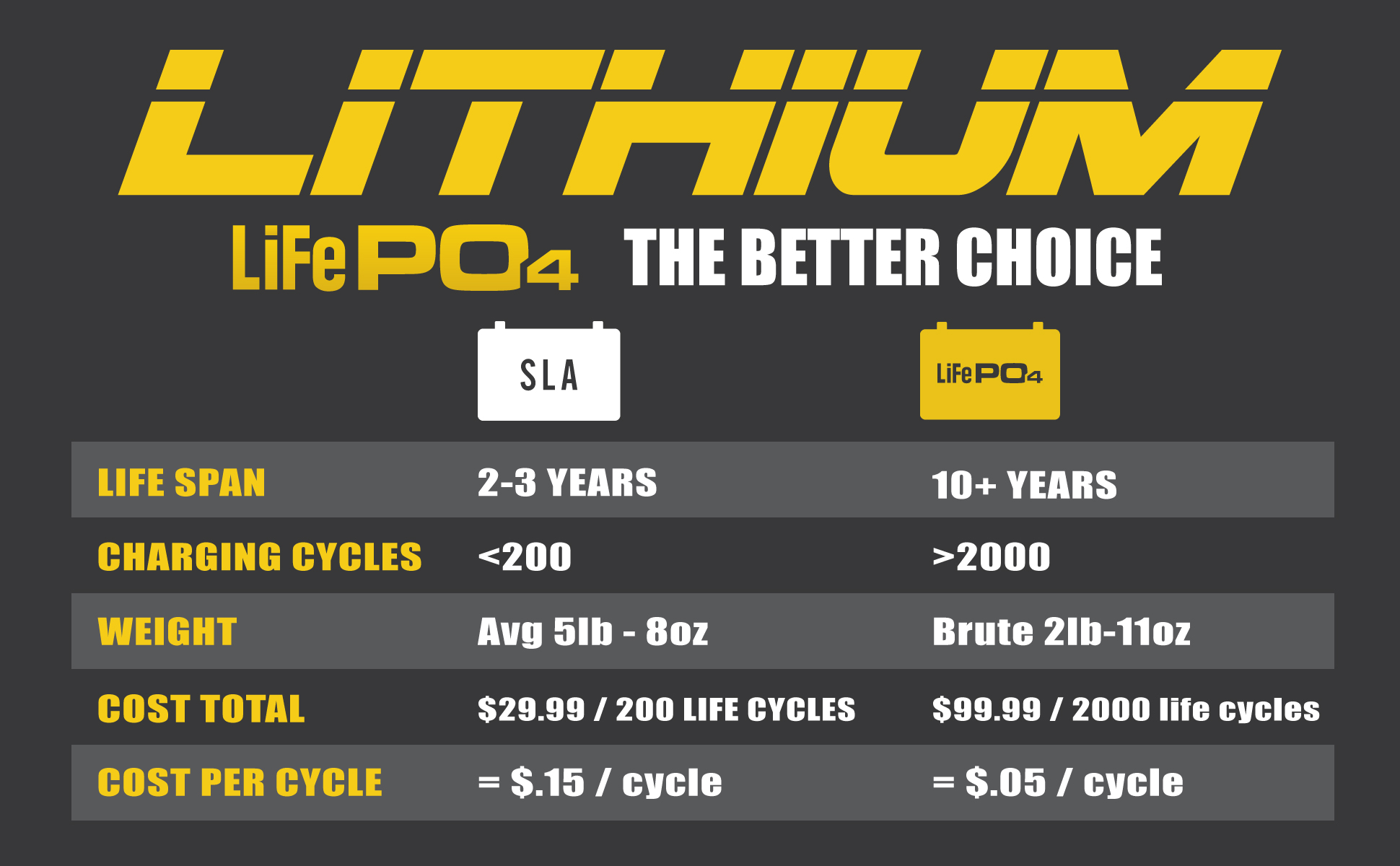The Lithium Advantage for Ice Fishing
If new to the sport or have taken a few years off, one glaring change from mere seasons ago is how Lithium fuel sources have taken the ice by storm. For good reason too, though there is a slightly higher cost of entry, the benefits of Lithium battery technology are many. For most anglers, the weight savings alone are enough to switch out their old Sealed Lead Acid (SLA) batteries, with new Lithium versions weighing less than half of their predecessors. You’ve also got longer run-times, even from batteries with similar amperage output that are not Lithium. That means you can fish for durations numbering days, not hours, with anglers often only re-charging their batteries after a long weekend of use.
Perhaps more importantly, overall cost of ownership is greatly reduced with Lithium battery technology on account of lifespan. 12V sealed lead acid batteries (SLA) of old had a life-cycle of mere years, with newer Lithium powered models easily doubling that. In fact, Lithium LiFePO4 batteries can attain 2,000 charge cycles or more, compared to the SLA batteries that top out around 200 lifetime charge cycles. That comes at a slightly higher cost of entry, but also offers a battery that pays for itself over the years, and becomes extremely reliable to the point of not needing backups or frequent replacement.
It stands to be noted that the adoption of Lithium power has been so complete, across multiple industries including ice, that MarCum has put nearly its entire fleet of sonar and flashers onto the Lithium train. That presents a tremendous value add for the end-user, as well as a game-changing fuel source that’s finally worthy of the ice fishing fish finder or underwater fishing camera you’re pairing it with.
12v Lithium Ion Battery
vs. Lithium 12v LiFePO4 Battery
What most anglers don’t know but should, is that not all Lithium is created equal. Lithium-ion (LiCoO2) technology is the original battery type to hit the scene. Overall, the chemistry is quite stable, and provides high-density energy to a variety of electronics, especially small ones. This density results in typically lighter weights, but more thermal sensitivity and less overall charge cycles over the battery’s lifetime. Lithium-ion batteries continue to be the choice for extreme lightweight needs, a thought that’s mimicked throughout the consumer electronics industry.
Lithium Iron Phosphate (LiFePO4) is a slightly different beast that has gained traction in recent years because of inherent advantages in the battery chemistry for some anglers. For starters, the technology is less energy-dense, resulting in a slight weight increase but greater range in operating temperatures. Coming from SLA batteries, LiFePO4 is still nearly half the comparable weight, but offers many more charge cycles in an incredibly safe, and stable platform. For that reason, most anglers are turning to LiFePO4 in greater numbers, with longer run-times that either SLA or Lithium-ion technology being another separator.
Charging is something rarely discussed in Lithium circles, but it’s imperative you charge Lithium with a charger designed for that specific chemistry. SLA chargers will put power to any Lithium battery, but they’ll do it less efficiently, and never approach full capacity. Lithium-ion and Lithium Iron Phosphate batteries should have their own individual lithium battery chargers that perform best given the chemistry they’re supplying power to, but that’s another detail quite often lost when making purchasing decisions. ALL MarCum Lithium batteries and units supplied with Lithium power have the appropriate charger for the job at hand.
Safety
Safety in Lithium is a topic front-and-center for a number of reasons. If you’ve noticed, anything Lithium that’s shipped, has its own set of warning labels, and there have even been specific batteries banned from use on commercial planes. That’s because Lithium in all its power and might can be dangerous if both positive and negative leads are bridged by a piece of metal. On ice or back home, that can be an ice scoop, another battery, or even in a charging scenario that leads to shorts, melted cables, and frayed wires.
When it comes to MarCum lithium batteries, LiFePO4 technology and advanced safety standards have made Lithium much safer for the end user. OSHA approved testing laboratories offer safety standards like UL 62133, which certify not just the batteries through inspection, but certify the shops producing them via random manufacturer inspection. They certify against mechanical failure, vibration, shock, temperature damage and a number of other stressors on the battery itself. This third-party, independent testing checks for external short circuit of both the cells and overall battery, free fall, cell crush, over-charging of the battery, and forced discharge of the cells.
It’s no secret that ice fishing presents some of the harshest conditions on Earth, all gear needs to be designed to withstand such rigors. On a 20-mile run through rough, jumbled ice, anglers need to know a battery is protected for drops, shakes, and mishaps of all kinds. Power surges, crossed leads, and improper use happens too. It’s simply a part of the sport that will always be, which is why MarCum invests so heavily in the safety aspect of the sport.
Looking Forward
Even with all that concern over safety and past doom and gloom, there’s simply no going back. It’s what gas augers were to hand augers, or what small motorcycle batteries were to anglers who used to lug a 100lb. car battery into a canoe. Lithium in the outdoors has greatly gained from the paths paved by other industries, and we as anglers are the recipients. That’s what’s made it so attractive from a performance standpoint, but more importantly, without sacrificing safety or additional dollars. Usually those upgrades come at a significant cost somewhere, which is why just like in cell phones or tablets, we’ll all just assume the tech is Lithium without having to make mention of it.
If you are looking for the best battery for ice fishing, check out this article.









